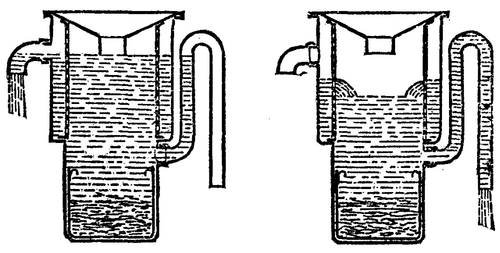Improved Catch Basin
Description
This section is from "Scientific American Supplement". Also available from Amazon: Scientific American Reference Book.
Improved Catch Basin
In 1882, M. Bacle published in Le Génie Civil a study of the sewer systems in some of the large foreign cities. There may be found there a description of the Liernur system at Amsterdam, Leyden, and Dordrecht, in Holland, and in certain cities of Germany and the United States.

IMPROVED CATCH BASIN.
This system consists in the employment of two distinct systems of ducts, one for the discharges from water-closets and the other for household wastes, rain water, and the discharges from factories when sufficiently purified. This arrangement allows the employment of sewers of small section, provided that it shall be unnecessary to enter them for the purpose of cleansing them. It has been necessary, therefore, to provide inlets with a separating apparatus called "gully" or "catch basin," which retains as completely as possible all solid matter, mud, excrement, and debris of every kind which maybe floated in by street washing or by rain-water, and which may be capable of causing stoppages in the sewers, the choking up being followed by fermentation and the emanation of noxious vapors.
M.C. Pieper of Berlin suggests a device for a catch basin, which appears to meet the requirements. It is in the form of a cylindrical metal box, enlarged in its upper section to receive a filtering cylinder of perforated sheet iron, which occupies almost the upper half of the device and rests upon the smaller lower part. The entire apparatus is covered by a movable funnel, through which enter water and any rubbish which it may carry with it. From one side a tube allows the liquid to be discharged, while a siphon placed on the opposite side serves the same purpose under certain circumstances, as will be explained.
Figure 1 represents the apparatus discharging under normal conditions. The heavy matter, sand, stones, etc., falls to the bottom into a receptacle which can be lifted out from time to time and emptied. The lighter buoyant matters, straw, vegetable debris, paper, etc., remain at the surface, and are retained by the filter; the water passing through the holes in the sheet iron rushes in a filtered condition through the annular space which exists in the upper part between the two cylinders, and escapes by the waste-pipe when the water reaches a proper level. If at a given moment the quantity of water flowing in is too much to be discharged through this waste-pipe, the level of the water mounts in the cylinder until it reaches the top of the siphon. Immediately the siphon comes into play and empties the upper part of the apparatus, and the filtered water contained in the annular space already mentioned quickly re-enters the cylinder through the perforated sheet iron, and in so doing cleans out the perforations with considerable energy.
This second period is represented in the second figure.
The mouth of the siphon being placed above the movable basket, the heavy matters contained in the latter are not in the least disturbed, and the metallic screen placed over the mouth prevents the entrance of any floating matters. When siphonic action ceases, the water in the short arm of the siphon empties itself into the main receptacle, and by so doing cleanses the screen. During a rain or the washing of the streets, the siphon can work in concurrence with the ordinary discharge-pipe. It is evident of course that these two - pipes can be placed on the same side of the apparatus, if this prove the most convenient arrangement.
We will add that this apparatus can be applied not only to the Liernur system, but also can be used for preventing the entrance of obstructions into sewers of the ordinary type, where the grade is small or where the quantity of water is insufficient; and if we adopt the system of "everything to the sewer," can we not find in the employment of this apparatus an element for the realization of the famous formula, "Always in circulation, and never in stagnation?" - Le Génie Civil.
Continue to:


